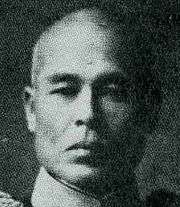Heisuke Yanagawa
| Heisuke Yanagawa | |
|---|---|
|
General Heisuke Yanagawa | |
| Native name | 柳川 平助 |
| Born |
October 2, 1879 Nagasaki prefecture, Japan |
| Died | January 22, 1945 (aged 65) |
| Allegiance | Empire of Japan |
| Service/branch |
|
| Years of service | 1900 -1945 |
| Rank | Lieutenant General |
| Commands held | IJA 1st Division, Taiwan Army, IJA 10th Army |
| Battles/wars | |
| Other work | Minister of Justice |
Heisuke Yanagawa (柳川 平助 Yanagawa Heisuke, 2 October 1879 – 22 January 1945) was a general in the Imperial Japanese Army in World War II.
Biography
Born in what is now part of Nagasaki city, Nagasaki prefecture, Yanagawa was raised in Ōita Prefecture by his adoptive parents. He graduated from the 12th class of the Imperial Japanese Army Academy in 1900, and served in combat during the Russo-Japanese War of 1904-1905. He graduated from the 24th class of the Army Staff College in 1912. After serving as an instructor in the Army Cavalry School, he was appointed a military attaché to China and served as an instructor at the Beijing Army College in 1918. He later traveled to Europe as part of Japan’s delegation to the Versailles Peace Treaty negotiations, and from 1920-1923 was a member of Japan’s delegation to the League of Nations.[1]
Around this time, he became involved in internal politics within the Japanese Army, and joined the Kodaha Faction, led by Sadao Araki, Jinsaburo Mazaki and Hideyoshi Obata.
From 1923-1925, Yanagawa was a cavalry officer, and rose steadily through the ranks from commanding the IJA 20th Cavalry Regiment in 1923, the IJA 1st Cavalry Brigade by 1927, the Cavalry School from 1929, to Inspector-General of Cavalry in 1930. He was promoted to lieutenant general in December 1931.
From 1932-1934, Yanagawa served as Vice-Minister of War. He was subsequently given a field posting as commander of the prestigious IJA 1st Division from 1934-1935. He commanded the Taiwan Army of Japan from 1935–1936, before his retirement on 26 September 1936.[2]
However, with the Second Sino-Japanese War, Yanagawa was recalled to active service and assigned command of the IJA 10th Army in China from 1937-1938. The 10th Army comprised the 18th and 114th divisions from Japan, the IJA 6th Division from North China, and the Kunisaki Detachment of the IJA 5th Division, and landed in Hangzhou on 5 November 1937.
Yanagawa led his troops in pursuit of Chinese forces fleeing from the Shanghai area, and was in command of one of the main Japanese columns at the Battle of Nanjing. His troops were later implicated in the Nanjing Massacre, but Yanagawa was repelled by the events.[3]
Yanagawa retired again from active military service in 1938, becoming Chief of the General Affairs Bureau, East Asia Development Board. Under the political patronage of Baron Hiranuma Kiichirō, and with support from the zaibatsu groups, he took over the Justice Ministry from Akira Kazami. During this post in government he led the Keishicho (Tokyo Metropolitan Police Department).
Yanagawa was a supporter of State Shintoism, along with General Kuniaki Koiso and Hiranuma Kiichirō, and in the creation of the Shintoist Rites Research Council. He was also a leader in the Taisei Yokusankai (Imperial Rule Assistance Association) group.
References
Books
- Dupuy, Trevor N. (1992). Encyclopedia of Military Biography. I B Tauris & Co Ltd. ISBN 1-85043-569-3.
- Chang, Iris (1998). The Rape of Nanking: The Forgotten Holocaust of World War II. Penguin. ISBN 0-14-027744-7.
- Dorn, Frank (1974). The Sino-Japanese War, 1937-41: From Marco Polo Bridge to Pearl Harbor. MacMillan. ISBN 0-02-532200-1.
- Tanaka, Masaaki (1998). What Really Happened in Nanking. Sekai Shuppan. ISBN 4-916079-07-8.
External links
- Ammenthorp, Steen. "Yanagawa Heisuke". The Generals of World War II.
Notes
| Preceded by Akira Kazami |
Minister of Justice Dec 1940-Jul 1941 |
Succeeded by Fumimaro Konoye |
